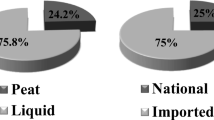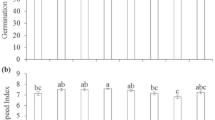Abstract
Eighteen samples of soybean inoculants representative of the major manufacturing companies in Argentina were purchased from the market and evaluated using plate counts, most probable number (MPN) of Bradyrhizobium japonicum on plants and time of nodule appearance. One or two B. japonicum isolates per product were isolated and typed by analysis of their DNA patterns. The Log10 numbers of B. japonicum obtained were in the range of 0 to 6/soybean seed, with only two products above 1 × 106 bacteria/seed. Of 18 products, 17 were contaminated, and of these 14 contained more contaminants than B. japonicum. The time of nodule appearance varied between 8 and 16 days, indicating a great difference in microbial activity between products. The strains were found to be similar to USDA 138 (five isolates), E45-INTA Argentina (two isolates), USDA 142 (four isolates) and E4-INTA (one isolate). Thus, even if most of the typed strains are considered as good N2-fixing strains, the average quality of the analysed samples was low, and could not support efficient inoculation of soybean.
Similar content being viewed by others
References
Asakawa, S. & Watanabe, K. 1993 Application of the First Order Reaction (FOR) model to nodulation by Bradyrhizobium japonicum in the nodulation-dilution frequency method and estimation of time of initiation of nodulation. Soil Science and Plant Nutrition 39, 733–736.
Bergersen, F.J. 1961 The growth of Rhizobium in synthetic media. Australian journal of Biological Sciences 14, 349–360.
Catroux, G. 1991 Inoculant quality standards and controls in France. In Expert consultation on legume inocu-lant production and quality control, Rome 19-21 March 1991, ed Thompson V.A. pp 113–120. Rome: FAO.
Date, R.A. & Roughley, R.J. 1977 Preparation of legume. In A treatise on dinitrogen fixation, eds Hardy, R.W.F. & Gibson, A.H. pp. 243–276. Chichester: John Wiley and Sons.
FAO 1992 Annuaire FAO, Production 46, pp. 115–116. Roma: FAO.
Gomez, M., Revellin, C., Hartmann, A. & Catroux, G. 1995 Improved enumeration of Bradyrhizobium japonicum in commercial inoculants using selective media. Letters in Applied Microbiology 21, 142–145.
Hartmann, A., Catroux, G. & Amarger, N. 1992 Bradyrhizobium japonicum strain identification by RFLP analysis using the repeated sequence RS-alpha. Letters in Applied Microbiology 15, 15–19.
Hiltbold, A.E., Thurlow, D.L & Skipper, H.D. 1980 Evaluation of commercial soybean inoculants by various techniques. Agronomy Journal 72, 675–681.
Hume, D.J. & Blair, D.H. 1992 Effect of numbers of Bradyhizobium japonicum applied in commercial inoculants on soybean seed yield in Ontario. Canadian Journal of Microbiology 38, 588–593.
Jardim Freire, J.R. 1985 Legume inoculant quality control. In Proceedings of the Workshop on Rhuzobium/Legume inoculants, Porto Alegre, 22-25 Oct. 1985, ed Jardim Freiore J.R., pp. 139–144. Rio Grande do Sul: Universidade Federal do Rio Grande do Sul.
Kaluza, K., Hahn, M. & Hennecke, H. 1985 Repeated sequences similar to insertion elements clustered around the Nif region of the Rhizobium japonicum genome. Journal of Bacteriology. 162, 535–542.
Lane, D.J. 1991 16S/23S rRNA Sequencing. In Nucleic acid techniques in bacterial systematics, eds Stackebrandt, E. & Goodfellow, M. pp 115–175. Chichester: John Wiley and sons.
Mallik, M.A.B. & Tesfai, K. 1983 Compatibility of Rhizobium japonicum with commercial pesticides in vitro. Bulletin of Environmental Contamination and Toxicology 31, 432–437.
Olsen, P.E., Rice, W.A., Bordeleau, L.M. & Biederbeck, V.O. 1994a Analysis and regulation of legume inoculants in Canada: The need for an increase in standards. Plant and Soil 161, 127–134.
Olsen, P.E., Rice, W.A. & Collins, M.M. 1994b Biological contaminants in North American legume inoculants. Soil Biology and Biochemistry 27, 699–701.
Pant, S.D. & Iswaran, V. 1972 Survival of Rhizobium japonicum in Indian soils. Philippine Journal of Science 101, 81–91.
Rennie, R.J. & Hynes, R.K. 1993 Scientific and legislative quality control of legume inoculants for lentil and field pea. Journal of Production Agriculture 6, 569–574.
Roughley, R.J. 1988 Legume inoculants: their technology and application. In Nitrogen fixation by legumes in Mediterranean agriculture, eds Beck, D.P. & Materon, L.A., pp. 260–268. Dordrecht: Martinus Nijhoff.
Sadowsky, M.J., Keyser, H.H. & Ben Bohlool, B. 1983. Biochemical characterization of fast-and slow-growing rhizobia that nodulate soybeans. International Journal of Systematic Bacteriology 33, 716–722.
Smith, R.S. 1992 Legume inoculant formulation and application. Canadian Journal of Microbiology 38, 485–492.
Somasegaran, P., Hoben, H., Halliday, J. 1982 The Niftal Manual for Methods in Legume Rhizobium Technology. College of Tropical Agriculture and Human resources, University of Hawai. U.S. Agency for International Development, pp. 7–13.
Somasegaran, P., Reyes, V.G. & Hoben, H.J. 1983 The influence of high temperatures on the growth and survival of Rhizobium spp. in peat inoculants during preparation, storage, and distribution. Canadian Journal of Microbiology 30, 23–30.
Thompson, J.A. 1988 Selection of Rhizobium strains. In Nitrogen fixation by legumes in Mediterranean agriculture, eds Beck, D.P. & Materon, L.A. pp. 207–223. Dordrecht: Martinus Nijhoff.
Vincent, J.M. 1970 A manual for the practical study of root nodule bacteria. Internationl Biological Programme, Handbook 15, Berkshire: Burgess and Son.
Weaver, R.W. & Frederick, L.R. 1974 Effect of inoculum rate on competitive nodulation of Glycine max L. Merril. II. Field studies. Agronomy Journal 66, 233–236.
Author information
Authors and Affiliations
Rights and permissions
About this article
Cite this article
Gomez, M., Silva, N., Hartmann, A. et al. Evaluation of commercial soybean inoculants from Argentina. World Journal of Microbiology and Biotechnology 13, 167–173 (1997). https://doi.org/10.1023/A:1018533629378
Issue Date:
DOI: https://doi.org/10.1023/A:1018533629378




